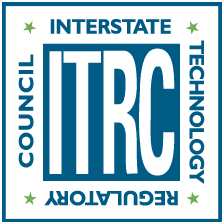Acknowledgments
The members of the Interstate Technology & Regulatory Council (ITRC) Soil Background and Risk Assessment (SBR) Team wish to acknowledge the individuals, organizations, and agencies that contributed to this guidance.
As part of the broader ITRC effort, the SBR Team effort is funded primarily by the U.S. Department of Energy. Additional funding and support have been provided by the U.S. Department of Defense and the U.S. Environmental Protection Agency.
The SBR team was led by Bonnie Brooks of the Washington Department of Ecology and Claudio Sorrentino of the California Department of Toxic Substances Control.
Team leaders were assisted by program advisors Jim Rocco and Lesley Hay Wilson of Sage Risk Solutions LLC.
Specifically, the team recognizes the efforts and important contributions of the following:
State and Local Government
Naji Akladiss
Maine Department of Environmental Protection
Patrick Boettcher
Delaware Department of Natural Resources and Environmental Control
Willliam Bosan
California Department of Toxic Substances Control
Robin Chinnery
Michigan Department of Environment, Great Lakes and Energy
Weiquan Dong
Nevada Division of Environmental Protection
Erin Endsley
Wisconsin Department of Natural Resources
Brian Faulkner
California Department of Toxic Substances Control
Debi Goodwin
Arizona Dept. of Environmental Quality
Brady Johnson
Idaho Department of Environmental Quality
Margaret Greene
Tennessee Department of Environment and Conservation
Paul Kulpa
Rhode Island Department of Environmental Management
Marsha Lay
Indiana Department of Environmental Management
Gail Lipfert
Maine Department of Environmental Protection
Adam McMahon
Idaho Department of Environmental Quality
Kathryn Morris
Montana Department of Environmental Quality
Norka Paden
Idaho Department of Environmental Quality
Anita Poulsen
Florida Department of Health
Jeff Rackow
Arizona Department of Environmental Quality
Jim Ridenour
New York State Department of Health
Divinia Ries
Michigan Department of Environment, Great Lakes and Energy
Shukla Roy-Semmen
California Department of Toxic Substances Control
Sandra Snyder
South Carolina Department of Health and Environmental Control
Harold Templin
Indiana Department of Environmental Management
Susan Turnblom
Oregon Department of Environmental Quality
Federal Government
Sydney Chan
USEPA
Felicia Barnett
USEPA ORD
Matthew Lambert
USEPA
Cynthia Auld
US Army Corps of Engineers
Amy Rosenstein
US Army Corps of Engineers
Laurel Woodruff
USGS
Academia
Marta Shore
University of Minnesota
Geoff Siemering
University of Wisconsin, Madison
Jennifer Weidhaas
University of Utah
Industry Affiliates
Mark Benotti
NewFields Companies LLC
Gino Bianchi-Mosquera
GSI Environmental, Inc.
Kelly Black
Neptune and Company, Inc.
Doug Blue
ExxonMobil
Mark Bruce
Eurofins
Brian Church
Windward Environmental, LLC
Regan Dahmer
ExxonMobil
Emily Davis
APTIM
Charlie DeWolf
Trihydro Corporation
Joann Dyson
GHD
Allison Geiselbrecht
Floyd|Snider
David Heidlauf
Ramboll
Michael Kierski
Exponent
Alexander Kliminsky
GHD
Jane Parkin Kullmann
Wood PLC
Kanan Patel-Coleman
Burns & McDonnell
Jay Peters
Haley & Aldrich, Inc.
Chrissy Peterson
EHS Support, LLC
Pamela Rodgers
Battelle Memorial Institute
Shahrokh Rouhani
NewFields Companies LLC
Barrie Selcoe
Jacobs
Leyla Shams
NewFields Companies LLC
Anita Singh
Brown and Caldwell
Tamara Sorell
Brown and Caldwell
Scott Stout
NewFields Companies LLC
James Studer
InfraSUR LLC
Anna Sutton
Cardno
Sagar Thakali
AECOM
Karen Thorbjornsen
APTIM
Allen Uhler
NewFields Companies LLC
Ann Verwiel
ToxStrategies, Inc.
Michael Worden
Civil & Environmental Consultants, Inc.


